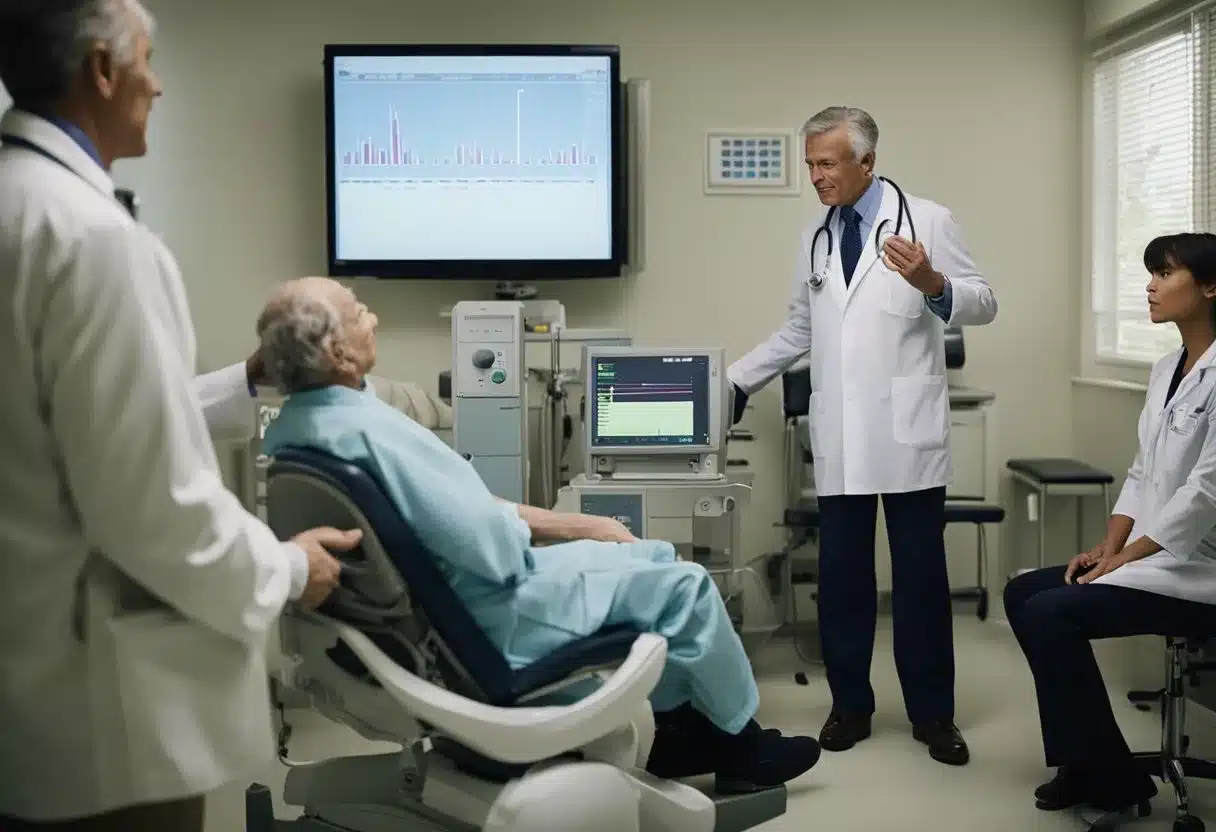Postural Orthostatic Tachycardia Syndrome (POTS) is a condition that affects the body’s autonomic nervous system. It is characterized by a sudden increase in heart rate and a drop in blood pressure when standing up from a sitting or lying position. This can cause a range of symptoms, including dizziness, lightheadedness, fatigue, and fainting.
POTS is a relatively uncommon condition, affecting an estimated 1 to 3 million Americans, with a higher prevalence in women than men. The exact cause of POTS is unknown, but it is thought to be related to dysfunction in the autonomic nervous system, which controls the body’s automatic functions such as heart rate, blood pressure, and digestion. POTS can be a challenging condition to diagnose and manage, but with proper treatment and lifestyle modifications, many people with POTS are able to lead full and active lives.
Key Takeaways
- POTS is a condition that affects the autonomic nervous system and causes a sudden increase in heart rate and drop in blood pressure when standing up.
- POTS is a relatively uncommon condition, affecting an estimated 1 to 3 million Americans, with a higher prevalence in women than men.
- With proper treatment and lifestyle modifications, many people with POTS are able to lead full and active lives.
Understanding POTS

Definition and Overview
Postural Orthostatic Tachycardia Syndrome (POTS) is a disorder of the Autonomic Nervous System that affects the flow of blood through the body, particularly when standing up. POTS is characterized by an increase in heart rate by 30 beats per minute or more, or a heart rate that exceeds 120 beats per minute within 10 minutes of standing up.
POTS is more common in women than men and is often first diagnosed in adolescents and young adults. The exact causes of POTS are not fully understood, but research suggests that it may be related to a malfunction of the Autonomic Nervous System, which controls involuntary bodily functions such as heart rate, blood pressure, and digestion.
Symptoms of POTS can vary widely and may include dizziness, lightheadedness, fainting, nausea, fatigue, and brain fog. These symptoms can be triggered by standing up, prolonged standing, or even sitting in an upright position for an extended period.
The Autonomic Nervous System
The Autonomic Nervous System is responsible for regulating many of the body’s involuntary functions, including heart rate, blood pressure, digestion, and respiratory rate. It is divided into two branches: the sympathetic nervous system and the parasympathetic nervous system.
The sympathetic nervous system is responsible for the body’s “fight or flight” response, which prepares the body to respond to stress or danger. It increases heart rate, constricts blood vessels, and raises blood pressure.
The parasympathetic nervous system, on the other hand, is responsible for the body’s “rest and digest” response, which promotes relaxation and digestion. It slows heart rate, dilates blood vessels, and lowers blood pressure.
In individuals with POTS, there may be a dysfunction in the Autonomic Nervous System, leading to an imbalance between the sympathetic and parasympathetic nervous systems. This can result in symptoms such as rapid heart rate, low blood pressure, and poor blood flow to the brain.
Symptoms of POTS

POTS is a condition that affects the body’s autonomic nervous system, which controls many of the body’s functions, such as heart rate, blood pressure, and digestion. The symptoms of POTS can vary from person to person, but they all involve a significant increase in heart rate upon standing up.
Common Symptoms
The most common symptoms of POTS include dizziness, lightheadedness, and fainting. These symptoms are usually triggered by standing up or sitting up after lying down. Other common symptoms include fatigue, brain fog, and nausea.
Heart-Related Symptoms
In addition to the common symptoms, POTS can also cause heart-related symptoms such as palpitations and an irregular heartbeat. These symptoms can be very distressing and can make it difficult to carry out everyday activities.
Additional Physical Symptoms
POTS can also cause a variety of other physical symptoms, such as headaches, chest pain, and shortness of breath. These symptoms can be very debilitating and can significantly impact a person’s quality of life.
Overall, the symptoms of POTS can be very distressing and can significantly impact a person’s quality of life. It is important to seek medical attention if you are experiencing any of these symptoms, as there are treatments available that can help manage the condition.
Causes and Triggers

Postural Orthostatic Tachycardia Syndrome (POTS) is a condition that affects the autonomic nervous system, which controls involuntary functions such as heart rate, blood pressure, and digestion. The exact cause of POTS is not fully understood, but there are several factors that can contribute to its development.
Primary Causes
Primary POTS, also known as idiopathic POTS, occurs when there is no underlying medical condition that can explain the symptoms. However, researchers have identified several potential primary causes of POTS, including:
- Neuropathic POTS: This type of POTS is caused by damage to the autonomic nerves that control blood flow and heart rate.
- Hypovolemic POTS: This type of POTS is caused by a decrease in blood volume, which can occur due to dehydration, blood loss, or other factors.
- Hyperadrenergic POTS: This type of POTS is caused by an overactive sympathetic nervous system, which can cause increased heart rate and blood pressure.
Risk Factors
Certain factors can increase a person’s risk of developing POTS, including:
- Ehlers-Danlos Syndrome: This is a genetic disorder that affects the connective tissues in the body and can lead to joint hypermobility and other symptoms.
- Viral Illness: Some viral infections, such as mononucleosis, can trigger the onset of POTS.
- Pregnancy: POTS can develop during pregnancy or shortly after giving birth.
- Puberty: POTS is more common in females and often develops during or after puberty.
Triggers
Various triggers can worsen POTS symptoms, including:
- Prolonged standing: Standing for long periods can cause blood to pool in the legs, leading to decreased blood flow to the brain and other organs.
- Hot temperatures: Exposure to hot temperatures can cause blood vessels to dilate, leading to decreased blood pressure and increased heart rate.
- Dehydration: Not drinking enough fluids can lead to decreased blood volume and worsen POTS symptoms.
- Stress and anxiety: Emotional stress and anxiety can activate the sympathetic nervous system and worsen POTS symptoms.
It is important for individuals with POTS to identify their triggers and take steps to avoid or minimize them. Treatment for POTS typically involves a combination of lifestyle modifications, such as increasing fluid and salt intake, wearing compression stockings, and avoiding triggers, as well as medication to control symptoms.
Diagnosis of POTS

Postural Orthostatic Tachycardia Syndrome (POTS) can be challenging to diagnose as there is no single test that can confirm the diagnosis. The diagnosis is usually made based on the patient’s clinical history, symptoms, and physical examination.
Diagnostic Criteria
The diagnostic criteria for POTS include a heart rate increase of more than 30 beats per minute or a heart rate that exceeds 120 beats per minute within 10 minutes of standing up. This increase in heart rate should not be associated with a drop in blood pressure. The symptoms should have been present for at least six months and should improve when the patient is lying down.
Testing for POTS
The most common test used to diagnose POTS is the tilt table test. During this test, the patient lies on a table that is tilted to an upright position. The patient’s heart rate and blood pressure are monitored while they are standing up. A doctor or cardiologist may also perform other tests, such as blood tests, to rule out other conditions that may cause similar symptoms.
Differential Diagnosis
POTS shares symptoms with other conditions, such as orthostatic hypotension, anxiety, and chronic fatigue syndrome. Therefore, it is essential to rule out these conditions before making a diagnosis of POTS. A neurologist may be consulted to help diagnose POTS and rule out other neurological conditions that may cause similar symptoms.
In conclusion, the diagnosis of POTS is based on a combination of clinical history, symptoms, and physical examination. The tilt table test is the most common test used to diagnose POTS. However, other tests may be necessary to rule out other conditions that may cause similar symptoms.
Treatment and Management
Lifestyle Modifications
Lifestyle modifications play an essential role in managing POTS. Patients should avoid standing or sitting for prolonged periods and engage in regular physical activity to improve blood flow and circulation. Compression stockings can also help reduce symptoms by preventing blood from pooling in the legs. Adequate sleep and hydration are also crucial in managing POTS symptoms.
Medications
Medications are often used to manage POTS symptoms. Fludrocortisone and midodrine are commonly prescribed medications that can help increase blood volume and constrict blood vessels, respectively. Beta-blockers and other medications that regulate heart rate may also be used to manage symptoms.
Dietary Considerations
Dietary modifications can also help manage POTS symptoms. Patients should increase their salt and water intake to help increase blood volume. Avoiding caffeine and alcohol can also help prevent dehydration and manage symptoms. Some patients may benefit from a high protein diet to help regulate blood sugar levels.
Physical Therapy
Physical therapy can help improve muscle strength and coordination, which can improve overall mobility and reduce the risk of falls. Patients can also work with a physical therapist to develop an exercise program that is tailored to their specific needs and abilities.
Overall, POTS treatment is highly individualized based on the patient’s symptoms and underlying conditions. A combination of lifestyle modifications, medications, dietary changes, and physical therapy can help manage symptoms and improve quality of life for POTS patients.
Living with POTS

People with POTS can experience a range of symptoms that can significantly impact their daily life. However, with some adjustments and coping strategies, many individuals with POTS are able to manage their symptoms and lead a fulfilling life.
Daily Life Adjustments
Individuals with POTS may need to make adjustments in their daily life to manage their symptoms. For example, they may need to avoid standing or sitting for long periods of time, and take frequent breaks to rest. They may also need to adjust their work schedule or duties to accommodate their symptoms.
In terms of diet, individuals with POTS may benefit from increasing their salt and fluid intake to help maintain blood volume and prevent dehydration. Eating smaller, more frequent meals may also be helpful in managing symptoms.
Coping Strategies
Coping strategies can also be helpful in managing symptoms of POTS. Some individuals find that compression garments, such as compression stockings, can help improve blood flow and reduce symptoms. Others may benefit from regular exercise, which can help improve cardiovascular function and reduce symptoms.
Stress management techniques, such as mindfulness and relaxation exercises, may also be helpful in managing symptoms. It is important for individuals with POTS to prioritize self-care and develop a support system to help manage their symptoms.
Support and Resources
There are a variety of resources available to individuals with POTS, including support groups, online forums, and educational materials. These resources can provide individuals with POTS with information and support to help manage their symptoms and improve their quality of life.
It is also important for individuals with POTS to work with their healthcare provider to develop a treatment plan that is tailored to their specific needs. This may include medications, lifestyle modifications, and other interventions to help manage symptoms and improve overall health.
It is worth noting that POTS is often associated with other conditions, such as Chronic Fatigue Syndrome and Fibromyalgia. Therefore, it is important for individuals with POTS to seek appropriate medical care and work with their healthcare provider to manage all of their health conditions.
Special Considerations

POTS in Women
POTS is more common in women than men. According to a study published in the Journal of the American Medical Association, 80% of POTS patients are female. Women with POTS may experience a worsening of symptoms during their menstrual cycle. This is because hormonal changes can affect blood pressure and heart rate.
POTS and Pregnancy
POTS can occur during pregnancy, but it is rare. According to a study published in the Journal of Obstetrics and Gynaecology, only 1% of pregnant women develop POTS. Women with POTS who become pregnant may experience an improvement in symptoms during the second and third trimesters. However, they may also experience a worsening of symptoms during labor and delivery.
Pediatric POTS
POTS can occur in children and adolescents. According to a study published in the Journal of Pediatrics, POTS is most commonly diagnosed in girls between the ages of 13 and 15. Children with POTS may experience symptoms such as dizziness, fatigue, and headaches. Treatment for pediatric POTS is similar to treatment for adult POTS, but may require additional monitoring and adjustments to medication dosages.
Overall, it is important for women with POTS to be aware of how their menstrual cycle may affect their symptoms, for pregnant women with POTS to be monitored closely by their healthcare provider, and for children with POTS to receive appropriate treatment and monitoring.
Research and Future Directions

Research on Postural Orthostatic Tachycardia Syndrome (POTS) is still in its early stages. While there have been some significant strides in understanding the condition, there is still much to learn. As a result, there is a need for further research to better understand the causes, symptoms, and treatments of POTS.
One area of research that shows promise is into the autoimmune and neuropathic causes of POTS. Studies have shown that some cases of POTS may be linked to autoimmune disorders, such as lupus or Sjogren’s syndrome. Additionally, neuropathic POTS, which is caused by damage to the nerves that control blood flow, is another area of research that is gaining traction.
Another area of research is into hyperadrenergic POTS, which is characterized by excess adrenaline in the bloodstream. This type of POTS is thought to be caused by an overactive sympathetic nervous system, and research is being conducted to better understand the mechanisms that lead to this condition.
In terms of future directions, there is a need for more funding and resources to be dedicated to POTS research. This includes the establishment of dedicated research centers and the development of standardized diagnostic criteria. Additionally, there is a need for more clinical trials to test the effectiveness of different treatments for POTS.
In conclusion, while there has been progress in understanding POTS, there is still much to learn. Continued research into the causes, symptoms, and treatments of POTS is necessary to improve the lives of those affected by this condition.
Frequently Asked Questions
What are the common symptoms of POTS?
The most common symptoms of POTS include dizziness, lightheadedness, fainting, rapid heartbeat, and fatigue. Patients with POTS may also experience headaches, brain fog, and difficulty concentrating. Symptoms can vary in severity and can be triggered by prolonged standing, hot weather, or physical exertion.
Can POTS be effectively treated, and if so, how?
Yes, POTS can be effectively treated. Treatment options include lifestyle changes, medications, and physical therapy. Lifestyle changes can include increasing fluid and salt intake, wearing compression stockings, and avoiding triggers. Medications such as beta blockers, fludrocortisone, and midodrine can also be effective. Physical therapy can help improve blood flow and strengthen muscles.
What diagnostic tests are used to confirm a case of POTS?
To confirm a case of POTS, doctors may perform a tilt table test, which measures heart rate and blood pressure while the patient is lying down and then tilted upright. Blood tests, electrocardiograms, and echocardiograms may also be used to rule out other conditions.
Is POTS considered a dangerous condition?
While POTS is not considered a life-threatening condition, it can significantly impact a patient’s quality of life. Fainting spells can lead to injury, and the chronic fatigue associated with POTS can make it difficult to carry out daily activities.
What are the primary causes behind the development of POTS?
The exact causes of POTS are not fully understood, but it is believed to be related to a dysfunction of the autonomic nervous system. POTS can be triggered by a variety of factors, including viral infections, surgery, trauma, and pregnancy.
Is it possible for POTS to resolve on its own over time?
In some cases, POTS can resolve on its own over time, particularly if it was triggered by an underlying condition that has been successfully treated. However, many patients require ongoing treatment and management to control symptoms and improve quality of life.